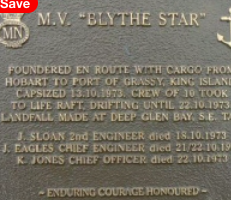50-Year Mystery Solved: Found MV Blythe Star

October 1973, MV (merchant vessel) Blythe Star, a coastal freighter, sank off Tasmania’s coast.
And, in April 2023, the MV Blythe Star was finally located by CSIRO, the Commonwealth Scientific and Industrial Research Organization, an Australian Government agency known for its in-depth scientific research.
The final voyage of MV Blythe Star
Departing on October 12, 1973, MV Blythe Star was headed for Bass Strait’s Currie on King Island, leaving from Prince of Wales Bay, Hobart. The cargo was superphosphate fertilizer (thought to be stacked in pallets) and many kegs of beer. Conditions on the sea were described as calm, with rolling swells (Wikipedia, MV Blythe Star.
Wikipedia tells us,
“Shortly after leaving Hobart, the vessel turned to starboard and set a course to King Island around the western side of Tasmania. By the next morning, with the weather and sea conditions still good, the vessel was a short distance off South West Cape when, between 8:00am and 8:30am, a sudden list developed to starboard. After briefly stabilising, the list quickly increased until much of the starboard side was below the waterline and seawater began entering the vessel through unsecured openings. Those crew members asleep below decks were thrown from their bunks, and all the crew struggled to make their way through rising water to the rear deck area. The capsize appears to have been completely unexpected by the crew, with the captain later quoted as saying:
“All seemed well, with nothing out of the ordinary. It was fine weather – beautiful weather. Suddenly there was a lurch. I thought ‘That’s really funny!’ Next thing I knew she was lying over on her starboard side.
“The ship’s lifeboat was unable to be launched due to the extreme list angle; however, an inflatable liferaft was released into the sea by the boatswain. Once inflated by his gas, the crew all managed to board it and it was cut free of the ship by young crewmember Michael Doleman. Very shortly after, Blythe Star’s bow lifted high and it sank stern-first into the Southern Ocean, approximately 5 nautical miles (9.3 km; 5.8 mi) west of South West Cape in 80 fathoms (480 ft; 146 m) of water. No distress call had been made by the captain at the time of the sinking.”
Survival of the crew
Wikipedia’s narrative adds, “The inflatable life raft to which the crew escaped was 12 feet (3.7 m) in diameter, covered with an orange canopy, and equipped with tinned water, old biscuits, some flares, two oars and a baling pail. In the rush to abandon ship, the emergency radio had been left on board Blythe Star; however, the crew expected to be quickly spotted by searchers or passing ships. This did not happen, and by several days into their ordeal the weather had worsened significantly. Keeping the raft upright and afloat took much effort, with big waves regularly collapsing the inflatable vessel onto itself, and water needing to be constantly bailed-out.
“Over the ensuing days, the raft drifted south-eastward around the south of Tasmania, increasingly distant from land. After three days of worsening conditions, John Sloan, the Second Engineer, died, possibly due to a lack of his normal medication, and he was slid into the sea the next evening. A welcome weather change then carried them north as far as Schouten Island off the Freycinet Peninsula, following which the raft drifted south-westerly approximately parallel to Tasmania’s eastern coastline. On the ninth day, they came close to a small rocky bay and the crew successfully made landfall on the Forestier Peninsula at Deep Glen Bay.
“Almost immediately, the nine survivors attempted to find an overland way out of the bay. The steep, precipitous cliffs and almost impenetrable vegetation made any progress exhausting, and within a short period another two crewmen, John Eagles and Ken Jones, died of suspected privations, exhaustion, and hypothermia. Eventually, the small group of Michael Doleman, Malcolm McCarroll and Alfred Simpson set out together and over the next day and night managed to scale the cliffs and force their way through the rainforest until they came to a rough track. Almost immediately, a vehicle was heard approaching, believed to be local forester Rod Smith, who told them that they were supposed to be dead. The three were eventually taken to the nearby township of Dunalley, where a helicopter was quickly arranged to collect the remaining four crew members from Deep Glen Bay. The men had not eaten in four days and memorial services had already been held for some of them. All seven survivors recovered despite spending time in the Royal Hobart Hospital. “
Content/photo source/credit: Wikipedia, “MV Blythe Star,” last edited October 19, 2023.



